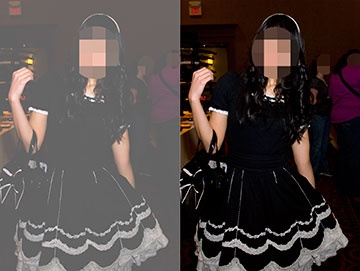My first idea would be to shoot images in RAW format, more specifically a general format like Adobe DNG if that is available in your camera. The reason is that you will be recording more image data in a loss-less format compared to JPEGs because RAW is recorded in 12 – 16 bits instead of 8 bits with lossy compression and set white balance. With more information, you will be able to recover highlights and hard areas with more success than otherwise. In most popular post-processing software that can edit raw files, there is a quick editing mode specifically used for RAW files that is displayed before the image will be opened in your editor. You are able to tweak various settings such as exposure, white balance, brightness, contrast, shadows, and saturation.

All of those settings can be useful, but just be careful to monitor your image’s overall look in relation to the histogram if that is available. Optionally you can add special effects such as darkened corners (vignetting) to an image to give it a sharp imperfect subject-focused look or add lens distortion which corrects or adds more to the field. Once your image has been tweaked and loaded into your editor, you are able to further modify the look and feel. Background blur can be added by isolating the subject manually, selecting the inverse of that, and applying a blur filter.
If you shoot a lot of images using available light and not strobe flash, you can use settings like “shadow/highlight” which will allow you to level out the exposure so that shadows can be brighter and highlights can be darker than they were initially captured. If your camera has good dynamic range, you will be able to level out most images to make them appear optimal in overall exposure and actually gain detail that was hidden. Once you have a level exposure, it might be a good idea to add back some contrast or saturation to make the image pop. Besides aspects like contrast, levels, white balance, and exposure, it is sometimes a good idea to go over the image and remove any dust spots with a tool that can clone out or heal a section of the image.
I just recently purchased a copy of Photoshop CS5 Standard as I had tried the demo and was seriously impressed with the RAW editor improvements. Over my old copy of Photoshop CS2 it includes new modifiers such as “Recovery” that pulls back bright blown highlights, “Fill Light” that brightens overly darkened areas, “Clarity” that improves sharpness with extra definition around object edges, and “Vibrance” which increases overall color usage. Besides the RAW improvements the editor itself has a photography layout customized toward a standard work-flow.
Often I use Photoshop actions to help in processing large batches of photos. I create an action that increases contrast as that is often all that is needed. This action also saves the file to disk as a high-resolution JPEG. After I have the action working, I link that up with the File >> Automate >> Batch… process that performs a Photoshop action on a directory of files. As I shoot DNG RAW files, I check the box to suppress the RAW editor from popping up. Before running the action I often go through the files in the RAW editor individually to fix any flaws. These changes will be included in the batch process. Overall I suggest you consider paying for a powerful piece of software like Photoshop. There really has never been a more useful tool in the 8 years I’ve been doing this.
- Overview
- Who is this for?
- What is convention photography?
- My experience and experiences
- Why be a part of this?
- Practice, practice, practice!
- Networking
- Fun
- Photography terms primer.
- Equipment
- It is important or not depending on your ideals
- A basic setup.
- Decide how you want to make it work.
- Framing and composition
- Full body shots.
- Portrait style.
- Skewed angles.
- Face in detail.
- Plane of focus.
- Rule of thirds and golden ratio
- Available light photography.
- Strobe photography.
- Removing harsh light.
- Flash brackets.
- Bokeh and blur maximization.
- Histogram reading and image review.
- Post processing.
- Various schools of thought.
- Available software on your OS of choice.
- Ideas on how to improve your processing.
- Business cards.
- Social networking.
- Website
- The process from start to finish.
- My equipment.
- Ask the person first.
- Interrupting people.
- Constrained areas.
- Physical activity.
- Summary
